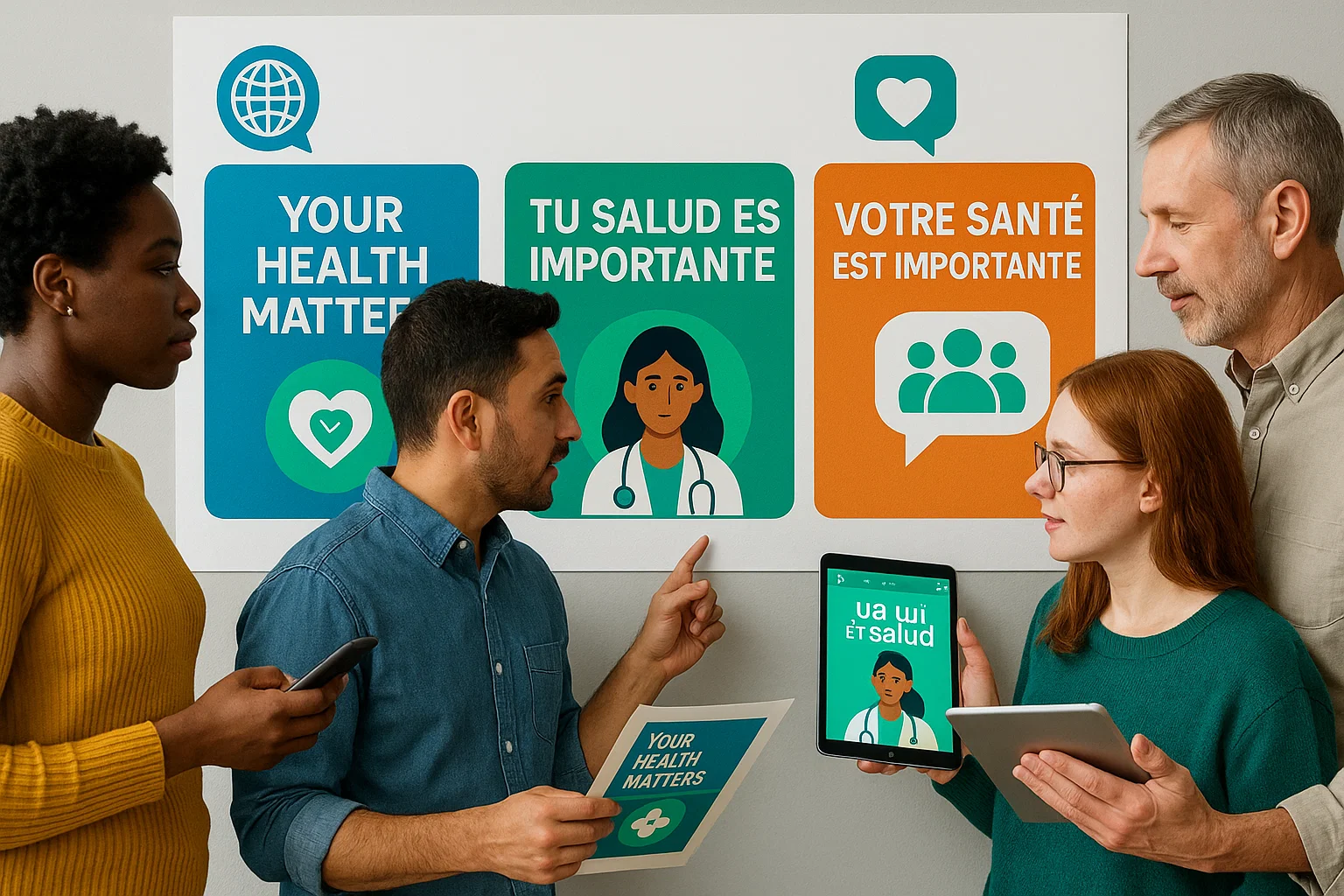Sarah discovers a lump in her breast. Terrified, she searches online for information and finds two hospitals’ websites.
Hospital A’s messaging: “World-class breast cancer care. Advanced technology. Expert surgeons. Exceptional outcomes. Schedule your appointment today.”
Hospital B’s messaging: “Finding a lump is frightening. You have questions, and you deserve honest answers. Here’s what happens next: We’ll schedule a diagnostic mammogram within 48 hours. Most lumps aren’t cancer—but if yours is, we’ll walk you through every option, explain each step clearly, and support you through treatment and beyond. You’re not alone in this.”
Both hospitals have excellent clinical programs. Both have compassionate physicians. But Sarah chooses Hospital B. Why? Because in her moment of vulnerability, one spoke to her fears with transparency and humanity, while the other recited credentials.
This is the power of transparent, patient-centered messaging. It transforms healthcare communication from institutional broadcasts about capabilities into human conversations about what patients actually need: information, reassurance, clarity, and the confidence that their chosen healthcare provider genuinely cares about them as people, not just patients.
Trust is healthcare’s currency. Patients must trust providers with their bodies, their health, their lives. Yet trust in healthcare institutions has been declining. According to Pew Research Center, only 34% of Americans express high confidence in hospitals and medical centers, down from 51% two decades ago.
The antidote? Messaging that prioritizes transparency over marketing spin, patient needs over institutional pride, and authentic human connection over polished corporate communications.
This comprehensive guide explores how healthcare organizations can build and maintain trust through messaging that puts patients first—addressing their real concerns, speaking to them as humans, being honest about limitations, and demonstrating genuine commitment to their wellbeing.
Understanding the Trust Crisis in Healthcare
Before building trust, understand why it’s eroded.
Factors Eroding Healthcare Trust
Cost opacity and surprise billing:
Patients can’t get straight answers about costs
Unexpected bills arrive months after care
Insurance coverage confusion
Financial surprise damages trust permanently
Communication breakdowns:
Rushed appointments where patients feel unheard
Medical jargon without translation
Conflicting information from different providers
Lack of follow-up or coordination
Institutional vs. individual focus:
Healthcare systems prioritize efficiency over experience
Patients feel like numbers, not people
Administrative hassles overshadow clinical care
Patient convenience sacrificed for institutional convenience
Overmarketing and underdelivering:
Promises of “patient-centered care” not matched by reality
Marketing claims feel hollow when contradicted by experience
Hype about being “best” or “#1” without substance
Disconnect between brand promise and brand delivery
Information asymmetry:
Patients lack information to make informed decisions
Healthcare “experts” withhold information (paternalistically or inadvertently)
Complex medical information not explained clearly
Questions discouraged or dismissed
Historical injustices:
Communities of color have legitimate distrust based on historical mistreatment
Women’s pain historically dismissed or minimized
Vulnerable populations exploited in research
These wounds remain and require acknowledgment
What Patients Actually Want
Research consistently shows patients prioritize:
To be heard and understood: Feel that providers genuinely listen and comprehend their concerns
Clear, honest information: Explanations in plain language about conditions, options, risks, and costs
Shared decision-making: Involvement in their care decisions, not paternalistic dictation
Compassion and empathy: Recognition of their fear, pain, and humanity
Transparency: Honesty about limitations, uncertainties, and mistakes
Convenience and respect: Systems that value their time and make care accessible
Follow-through: Promises kept, questions answered, continuity maintained
According to Beryl Institute research, patients consistently rate communication, empathy, and transparency as more important than clinical credentials when choosing healthcare providers.
The Foundation: What Patient-Centered Really Means
“Patient-centered” has become healthcare marketing cliché. True patient-centeredness requires fundamental mindset shift.
From Institution-Centered to Patient-Centered
Institution-centered messaging:
“We are the region’s leading cancer center”
“Our physicians are nationally recognized”
“We offer the most advanced technology”
”We have been serving the community for 100 years”
Focus: Our capabilities, our awards, our history
Patient-centered messaging:
“Cancer is overwhelming. We’ll guide you through every step”
“Our team listens carefully to understand your unique situation”
“Advanced technology helps us find answers faster, with less discomfort”
“Generations of families have trusted us because we treat you like family”
Focus: Your needs, your experience, your outcomes
The difference: Patient-centered messaging starts with patient perspective, acknowledges their feelings, and positions institutional capabilities as solutions to their needs—not accomplishments demanding admiration.
The Patient Journey Mindset
Effective patient-centered messaging requires understanding the complete patient experience:
Awareness stage: “Something’s wrong. I’m worried.”
Patient needs: Information about symptoms, causes, when to seek care
Messaging focus: Education, reassurance, reducing anxiety
Tone: Empathetic, non-alarmist, helpful
Research stage: “I need care. Who should I trust?”
Patient needs: Understanding options, comparing providers, evaluating quality
Messaging focus: Differentiators, outcomes, patient experiences
Tone: Honest, substantive, evidence-based
Decision stage: “I’ve chosen a provider. Now what?”
Patient needs: Practical information about scheduling, preparation, costs
Messaging focus: Clear next steps, logistics, expectations
Tone: Practical, straightforward, supportive
Care experience: “I’m in your hands. Please treat me well.”
Patient needs: Respect, communication, comfort, competence
Messaging focus: What to expect, who to contact, how to prepare
Tone: Caring, professional, attentive
Recovery/ongoing: “How do I get better? What happens next?”
Patient needs: Recovery guidance, follow-up coordination, ongoing support
Messaging focus: Self-care instructions, warning signs, resources
Tone: Encouraging, thorough, accessible
Advocacy stage: “I want to help others.”
Patient needs: Ways to share experience, support others, give back
Messaging focus: Testimonial opportunities, support groups, advocacy
Tone: Grateful, empowering, community-focused
Strategy 1: The Language of Transparency
How you say things matters as much as what you say.
Plain Language Principles
Avoid medical jargon:
“Myocardial infarction requiring percutaneous coronary intervention”
“Heart attack treated by opening blocked arteries”
Use short, clear sentences:
“In the event that you experience symptoms including but not limited to chest pain, shortness of breath, or dizziness, it is advisable to seek immediate medical attention”
“Call 911 if you have chest pain, trouble breathing, or feel dizzy”
Active voice, not passive:
“The procedure will be performed by your surgeon”
“Your surgeon will perform the procedure”
Concrete, not abstract:
“We facilitate patient-centered care delivery”
“We listen to you, explain your options, and involve you in decisions”
Define necessary medical terms:
“Biopsy (removing a small tissue sample for testing)”
”Benign (not cancerous)”
“Chronic (long-lasting or recurring)”
The Honesty Framework
Acknowledge uncertainty:
“This treatment will cure your condition”
“This treatment helps most patients, though results vary. We’ll monitor closely and adjust if needed”
Discuss realistic outcomes:
“Completely painless recovery”
“Most patients experience some discomfort for 2-3 days, manageable with prescribed medication”
Address risks honestly:
Omitting side effects or complications
“Like all surgeries, this carries risks including infection (2-3% of patients), bleeding, and anesthesia reactions. We’ll discuss these in detail”
Admit limitations:
“We treat all conditions”
“While we don’t treat [specific condition], we can refer you to excellent specialists who do”
Own mistakes transparently:
Defensive or evasive language
“We made an error in your billing. We’re sorry, we’ve corrected it, and we’re improving our process to prevent this”
Empathetic Language
Acknowledge emotions:
“We know this diagnosis is frightening”
”It’s normal to feel overwhelmed”
“Your concerns are valid and important”
Validate experiences:
“Many patients tell us they feel rushed during appointments”
“We hear from patients that insurance is confusing”
“You’re not alone in feeling this way”
Express compassion:
“We care about you and your wellbeing”
“Your comfort and peace of mind matter to us”
“We’re here to support you through this”
Use “we” and “you” thoughtfully:
”We’re in this together”
“We’ll walk through this with you”
“You don’t have to face this alone”
According to the Agency for Healthcare Research and Quality, patients who receive information in plain language are 2-3 times more likely to understand their conditions and follow treatment plans.
Strategy 2: Addressing Patient Fears and Concerns Directly
Patient-centered messaging confronts anxieties head-on rather than ignoring them.
Common Patient Fears
Fear of pain:
Directly address: “Will this hurt?”
Transparent response: “You’ll feel some pressure during the procedure. We use local anesthesia so you won’t feel pain, though you may have soreness afterward. We’ll prescribe medication to keep you comfortable”
Fear of bad news:
Directly address: “What if it’s cancer?”
Transparent response: “If we find cancer, we’ll explain exactly what type, what stage, and all your treatment options. Many cancers are highly treatable, especially when caught early. Whatever we find, we’ll guide you through it”
Fear of cost:
Directly address: “Can I afford this?”
Transparent response: “We’ll provide a cost estimate before treatment. If cost is a concern, our financial counselors can discuss payment plans and financial assistance programs. Please don’t let cost prevent you from getting necessary care”
Fear of the unknown:
Directly address: “What will happen?”
Transparent response: “Here’s exactly what to expect: [step-by-step walkthrough]. We’ll explain each step before we do it. You can ask questions anytime”
Fear of judgment:
Directly address: “I’m embarrassed about…”
Transparent response: “We treat many patients with this condition. You won’t be judged—we’re here to help, not criticize. Everything you tell us is confidential”
Fear of being dismissed:
Directly address: “Will you take me seriously?”
Transparent response: “Your symptoms and concerns are important. We’ll listen carefully, investigate thoroughly, and keep working with you until we find answers”
Preemptive Communication
Address concerns before patients ask:
What to expect content:
“Your First Visit: What Happens”
“Preparing for Surgery: A Complete Guide”
“Recovery Timeline: Week by Week”
Common questions pages:
Anticipate questions patients are too afraid or embarrassed to ask
Provide thorough, honest answers
Update based on actual patient questions
Cost transparency:
Price estimates for common procedures
Insurance acceptance information
Financial assistance options
Payment plan details
Outcomes data:
Success rates for procedures
Patient satisfaction scores
Quality and safety metrics
Honest comparison to benchmarks
Strategy 3: Visual and Structural Transparency
Trust isn’t just built through words—design and structure communicate transparency.
Website Design for Transparency
Clear navigation:
Find information easily
No hiding important details in fine print
Prominent contact information
Easy access to cost, insurance, and practical information
Provider transparency:
Complete physician profiles (education, experience, specialties)
Photos showing actual facilities and team (not stock images)
Honest bios written in human language
Patient reviews and ratings displayed prominently
Visual hierarchy:
Most important information most prominent
Critical details (costs, risks, contact) easy to find
Scannable format with headings and bullets
White space making content digestible
Accessibility:
Screen reader compatible
Large, readable fonts
High contrast for visibility
Available in multiple languages
ADA compliant
Content Formats That Build Trust
Video transparency:
Virtual facility tours showing actual locations
Physicians explaining procedures in their own words
Real patients (with permission) sharing experiences
Behind-the-scenes looks at care processes
Infographics and visuals:
Complex processes explained visually
Step-by-step procedure guides
Recovery timelines illustrated
Anatomical diagrams for understanding
Interactive tools:
Symptom checkers with appropriate disclaimers
Procedure cost estimators
Risk assessment tools
Treatment comparison tools
Third-party validation:
Quality ratings from external organizations
Accreditations and certifications
Patient satisfaction scores from independent surveys
Awards and recognition (used judiciously, not boastfully)
Strategy 4: Consistency Across All Touchpoints
Trust erodes when messaging varies between channels.
Omnichannel Message Consistency
Website to phone:
Information on website matches what staff says
Scripts align with web content
Staff trained on current messaging
Marketing to reality:
Brand promises reflected in actual experience
Claims substantiated by outcomes data
Visual identity matches facility appearance
Digital to physical:
Signage reflects website information
Forms and brochures use consistent language
Physical environment matches visual brand
Pre-visit to in-visit:
Expectations set beforehand match reality
No surprises on day of appointment
Continuity of information
Staff as Message Ambassadors
Training on patient-centered communication:
Every staff member understands messaging principles
Phone scripts reflect transparency and empathy
Front desk trained to explain processes clearly
Clinical staff communicate in patient-friendly language
Empowering staff to be honest:
Staff can acknowledge when they don’t know something
Permission to escalate complex questions
Support for transparent conversations
Recognition for patient-centered communication
Consistent patient education:
All staff provide same information
Written materials support verbal education
Multiple formats for different learning styles
Teach-back method to confirm understanding
Strategy 5: Transparency About Costs
Nothing erodes trust faster than financial surprises.
Price Transparency Best Practices
Clear cost information:
Price estimates for common procedures
Range rather than single number when costs vary
What’s included vs. additional costs
Out-of-pocket estimates by insurance type
Upfront financial conversations:
Discuss costs before treatment when possible
Financial counseling available
Payment plans clearly explained
Insurance verification proactive
Billing transparency:
Clear, detailed bills in plain language
Itemization that makes sense to patients
Easy process to question charges
Multiple payment options
Financial assistance transparency:
Eligibility criteria clearly stated
Application process straightforward
Timeline for decisions communicated
No shame or stigma in asking
Honest limitations:
“Costs may vary based on your specific situation”
“We can provide estimates, but final costs depend on insurance”
“Some charges may come from separate providers”
According to Healthcare Financial Management Association research, transparent pricing increases patient satisfaction by 40% and reduces complaints by 60%, even when prices are higher than patients hoped.
Strategy 6: Admitting and Learning from Mistakes
Transparency includes how you handle errors.
The Apology Framework
Acknowledge the mistake clearly:
“If you felt there was a problem…”
“We made an error in your medication dosage”
Take responsibility:
“Mistakes happen in healthcare”
“We should have caught this. I’m sorry we didn’t”
Explain what happened (appropriately):
Brief explanation without excessive detail or defensiveness
Focus on the fact and impact, not excuses
Describe corrective action:
What you’re doing to fix the immediate problem
What you’re changing to prevent recurrence
Timeline for implementation
Invite ongoing dialogue:
“Please contact me directly if you have questions”
“We’ll follow up to ensure everything is resolved”
“Your feedback helps us improve”
Building Trust Through Vulnerability
Admit limitations:
”We don’t offer that service, but [competitor] does”
“I don’t know the answer, but I’ll find out”
“This is outside my expertise; let me connect you with someone who specializes in it”
Acknowledge uncertainty:
”Medical science doesn’t have all the answers yet”
“Every patient responds differently”
”We’ll need to monitor and adjust as we learn how you respond”
Share quality data honestly:
Report outcomes transparently, including complications
Compare to benchmarks honestly
Explain improvement efforts
Celebrate progress while acknowledging room for growth
Humanize your organization:
Share behind-the-scenes challenges
Acknowledge systemic healthcare problems
Express frustration with industry issues affecting patients
Position as partners navigating broken system together
Strategy 7: Measuring Trust and Transparency
You can’t improve what you don’t measure.
Trust Metrics
Patient satisfaction questions specifically about trust:
”I trust this healthcare provider to put my needs first”
“This organization is honest and transparent with me”
“I feel comfortable asking questions and expressing concerns”
“This provider explained things in ways I could understand”
“I received clear information about costs before treatment”
Net Promoter Score (NPS):
“How likely are you to recommend us?” (0-10 scale)
Follow-up: “What’s the primary reason for your score?”
Analyze verbatim comments for trust themes
Behavior-based trust indicators:
Return rate for ongoing care
Acceptance of recommended treatments
Adherence to treatment plans
Referrals generated
Online review sentiment analysis
Communication effectiveness metrics:
Percentage of patients reporting clear understanding
Questions asked (more questions = better communication comfort)
Patient portal engagement (trust in digital communication)
Patient education material downloads
Transparency Audit
Regular reviews of:
Website content for clarity and honesty
Marketing materials for accuracy and balance
Patient education materials for readability
Cost information for completeness
Staff communication for consistency
Patient feedback:
“Was anything unclear or confusing?”
“What information did you wish you had received earlier?”
“Did anything surprise you negatively?”
“What would have made you feel more informed?”
Mystery shopping:
Call center scripts for transparency
Appointment scheduling experience
Website navigation for cost information
Staff responsiveness to questions
Real-World Examples: Transparency in Action
Learn from organizations doing it well.
Example 1: Cleveland Clinic’s Video Transparency
What they did: Created extensive library of videos showing procedures, explaining conditions, and featuring real patients and physicians
Why it builds trust:
Shows actual facilities and team, not stock footage
Physicians explain in accessible language
Real patient experiences provide authentic perspective
Demonstrates confidence in quality of care
Results: Significantly increased patient confidence and appointment bookings from distant markets
Example 2: Oklahoma Surgery Center’s Price Transparency
What they did: Published all-inclusive prices for procedures online, with no hidden fees
Why it builds trust:
Eliminates biggest patient concern (surprise costs)
Demonstrates respect for patients’ financial needs
Shows confidence in value proposition
Reduces administrative burden of cost questions
Results: Attracted patients from across country; increased market share despite higher prices than some competitors
Example 3: Virginia Mason’s Patient Safety Transparency
What they did: Publicly report medical errors and improvement efforts
Why it builds trust:
Demonstrates commitment to honesty over image
Shows systematic approach to quality
Humanizes healthcare (acknowledges imperfection)
Invites patients as partners in safety
Results: Improved patient trust scores; reduced malpractice claims; attracted quality-conscious patients
Conclusion: Trust as Competitive Advantage
In healthcare’s increasingly competitive, consumer-driven landscape, trust is the ultimate differentiator. Clinical quality has become table stakes—most hospitals provide competent care. Technology proliferates—everyone claims the latest equipment. Convenience improves—many systems offer online scheduling and telehealth.
But trust? Trust remains rare. Trust requires vulnerability. Trust demands consistency. Trust takes time.
The healthcare organizations that will thrive aren’t those shouting loudest about being “best” or “#1″—they’re those earning trust through:
Honest communication: Speaking truth even when it’s uncomfortable
Patient-focused language: Starting with patient needs, not institutional pride
Transparency: Opening books, sharing data, admitting limitations
Consistency: Delivering on promises across every touchpoint
Empathy: Acknowledging fear, pain, and humanity
Accountability: Owning mistakes and improving
Follow-through: Doing what you say you’ll do
Patients don’t expect perfection. They expect honesty. They don’t need you to be the best at everything. They need you to be truthful about what you’re good at, what you’re not, and what they can realistically expect.
Transparent, patient-centered messaging isn’t just about better marketing—it’s about better healthcare. When patients trust their providers, they:
1. Seek care earlier (better outcomes)
2. Communicate more openly (better diagnosis)
3. Follow treatment plans (better results)
4. Return for ongoing care (better prevention)
5. Refer others (growth)
Building this trust doesn’t require massive budgets or sophisticated technology. It requires commitment to:
Listen more than you speak
Explain more than you assume
Show more than you tell
Admit more than you spin
Serve more than you promote
Your patients are entrusting you with what matters most—their health, their bodies, their lives. Honor that trust with messaging worthy of it.
Be transparent. Be honest. Be human.
Your patients will notice. Your community will respond. Your organization will grow.
And healthcare will be better for it.
References
- Pew Research Center. (2024). “Public Trust in Healthcare Institutions.” Retrieved from https://www.pewresearch.org/
- The Beryl Institute. (2024). “Patient Experience and Trust: What Matters Most.” Retrieved from https://www.theberylinstitute.org/
- Agency for Healthcare Research and Quality (AHRQ). (2024). “Health Literacy and Patient Safety.” Retrieved from https://www.ahrq.gov/
- Healthcare Financial Management Association (HFMA). (2024). “Price Transparency and Patient Satisfaction.” Retrieved from https://www.hfma.org/
- Institute for Healthcare Improvement (IHI). (2024). “Patient-Centered Communication.” IHI Resources.
- Press Ganey. (2024). “Patient Experience Trends: Trust and Communication.” Press Ganey Research.
- Advisory Board. (2024). “Building Patient Trust Through Communication.” Retrieved from https://www.advisory.com/
- Harvard Business Review. (2024). “The Transparency Imperative in Healthcare.” Retrieved from https://hbr.org/
- Journal of Healthcare Management. (2024). “Communication, Trust, and Patient Outcomes.” American College of Healthcare Executives.
- Health Affairs. (2024). “Patient-Centered Communication and Health Outcomes.” Retrieved from https://www.healthaffairs.org/
- American Medical Association. (2024). “Patient Communication Best Practices.” Retrieved from https://www.ama-assn.org/
- Patient Experience Journal. (2024). “Transparency and Trust in Healthcare Settings.” Patient Experience Institute.
- NEJM Catalyst. (2024). “Building Trust in Healthcare: Evidence and Practice.” Massachusetts Medical Society.
- Becker’s Hospital Review. (2024). “Patient Communication and Trust Strategies.” Becker’s Healthcare.
- Society for Healthcare Strategy & Market Development (SHSMD). (2024). “Patient-Centered Marketing Communications.” American Hospital Association.




